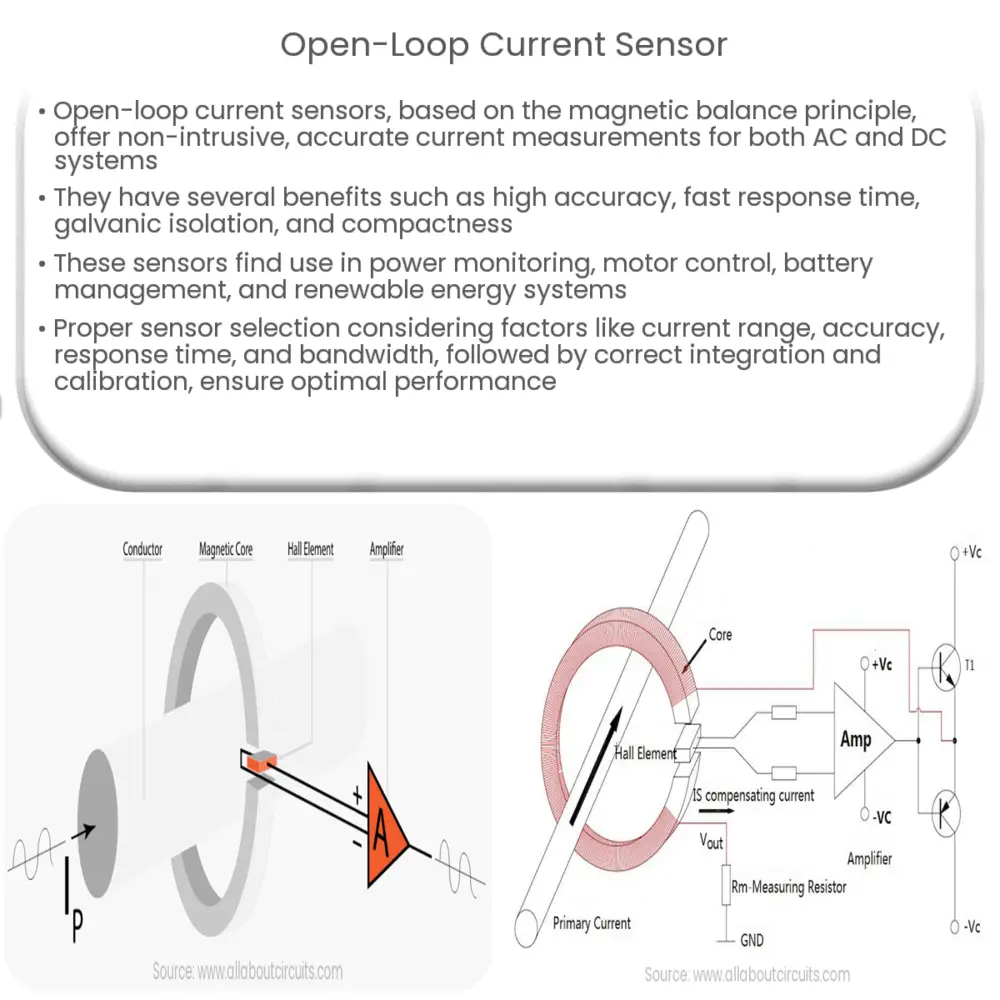Open-loop current sensors measure AC/DC currents non-intrusively, offering isolation, accuracy, fast response, and wide bandwidth for various applications.

Open-Loop Current Sensors: An Introduction
Overview of Open-Loop Current Sensors
Open-loop current sensors are a type of electrical device used to measure alternating and direct currents in power systems. They provide an isolated and accurate measurement of current flowing through a conductor without interrupting the circuit. This allows for precise monitoring and control of electrical devices, ensuring efficient operation and reducing the risk of faults or failures. In this article, we will delve into the working principle of open-loop current sensors, their advantages, and applications.
Working Principle
Open-loop current sensors are based on the magnetic balance or zero-flux principle. They consist of a primary conductor, a magnetic core, a secondary winding, and a sensor element. The primary conductor carries the current to be measured, while the magnetic core and secondary winding form a closed magnetic circuit around the conductor.
When current flows through the primary conductor, it generates a magnetic field proportional to the current value. This magnetic field induces an opposing voltage in the secondary winding, which is then detected by the sensor element. The sensor output is a voltage signal proportional to the primary current, providing a non-intrusive and accurate current measurement.
Advantages of Open-Loop Current Sensors
Open-loop current sensors offer several benefits compared to other current sensing techniques, such as closed-loop sensors and shunt resistors:
- Isolation: These sensors provide galvanic isolation between the primary and secondary circuits, reducing the risk of electrical faults and ensuring safety in high-voltage applications.
- Accuracy: Open-loop sensors offer high accuracy and linearity over a wide range of currents, making them suitable for various applications, including power monitoring, motor control, and battery management.
- Fast response time: The sensors exhibit a fast response time, allowing for real-time current monitoring and control, essential in dynamic systems such as electric vehicles and industrial equipment.
- Wide bandwidth: These sensors have a broad frequency bandwidth, enabling them to measure currents in both AC and DC systems accurately.
- Compact and lightweight: Open-loop sensors are typically smaller and lighter than closed-loop sensors, making them ideal for space-constrained applications.
Applications of Open-Loop Current Sensors
Open-loop current sensors are employed in various industries and applications due to their versatility and performance advantages. Some common uses include:
- Power quality monitoring in electrical distribution systems
- Motor control and protection in industrial automation
- Battery management systems for electric vehicles and energy storage
- Renewable energy systems such as solar inverters and wind turbine controllers
- Switch-mode power supplies and converters
Selecting the Right Open-Loop Current Sensor
When choosing an open-loop current sensor for a specific application, it is crucial to consider several factors to ensure optimal performance and compatibility:
- Current range: Select a sensor with a suitable primary current range for the application, taking into account the maximum and minimum currents that need to be measured.
- Accuracy: Determine the required accuracy for the application and choose a sensor that meets or exceeds this specification.
- Response time: For applications with rapidly changing currents, select a sensor with a fast response time to ensure accurate measurements.
- Bandwidth: Consider the frequency range of the currents to be measured and select a sensor with an appropriate bandwidth.
- Temperature range: Choose a sensor capable of operating in the expected temperature range of the application environment.
- Physical dimensions: Ensure the sensor’s size and form factor are suitable for the available space in the system.
Integration and Calibration
Proper integration and calibration are critical for achieving accurate and reliable measurements with open-loop current sensors. Follow these steps to ensure optimal performance:
- Ensure the primary conductor is correctly positioned within the sensor’s magnetic core to avoid measurement errors caused by magnetic field interference.
- When integrating the sensor into a circuit, minimize the length of the leads between the sensor and the associated electronics to reduce noise and improve measurement accuracy.
- Calibrate the sensor to account for variations in temperature, manufacturing tolerances, and other factors that may affect performance. Many open-loop current sensors include temperature compensation and gain adjustment features to simplify this process.
Conclusion
Open-loop current sensors are a versatile and effective solution for measuring electrical currents in various applications. Their key advantages, such as high accuracy, fast response time, and galvanic isolation, make them an ideal choice for power quality monitoring, motor control, battery management, and renewable energy systems. By considering factors such as current range, accuracy, response time, and bandwidth when selecting a sensor, and by ensuring proper integration and calibration, you can achieve reliable and accurate current measurements to optimize the performance of your electrical system.

